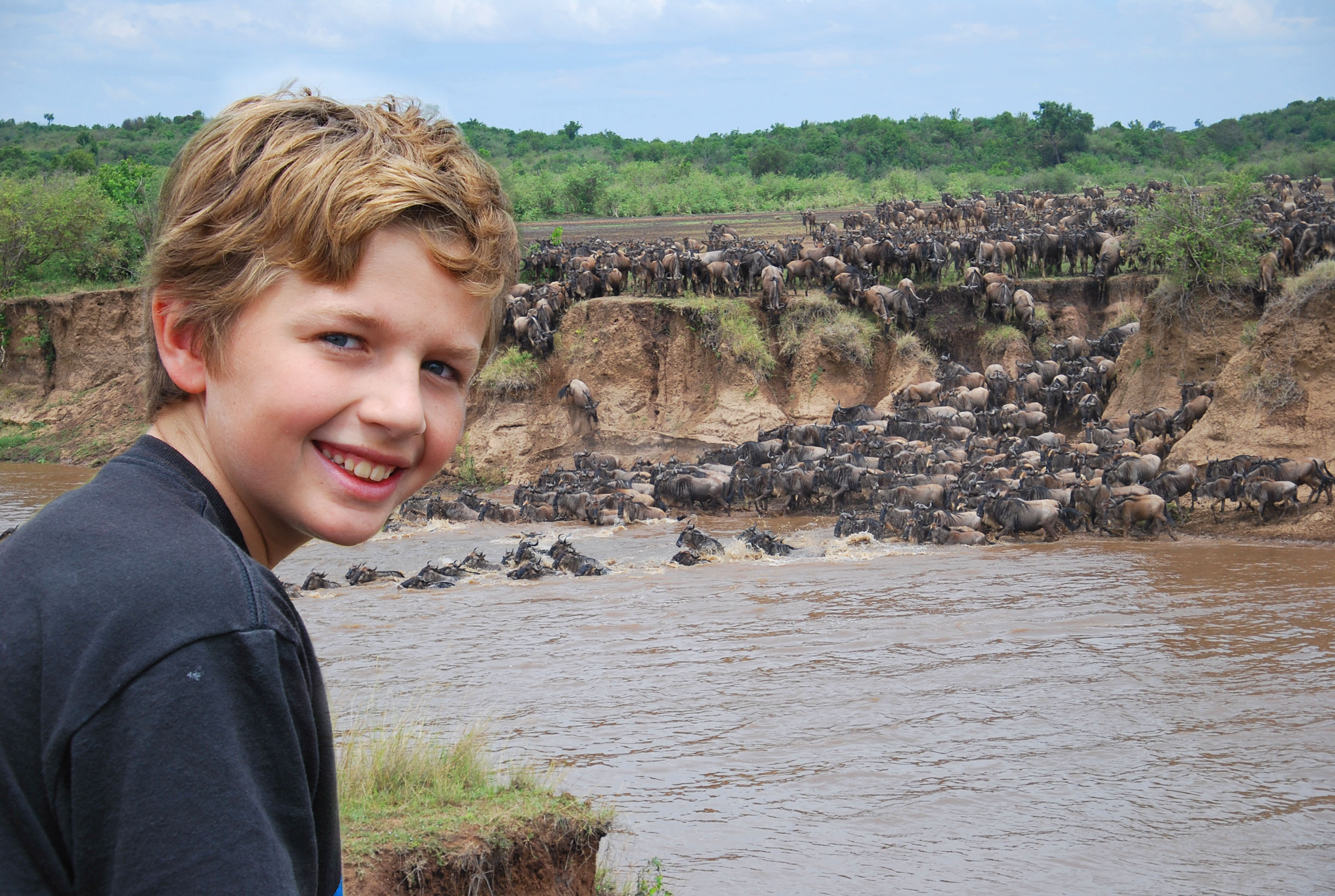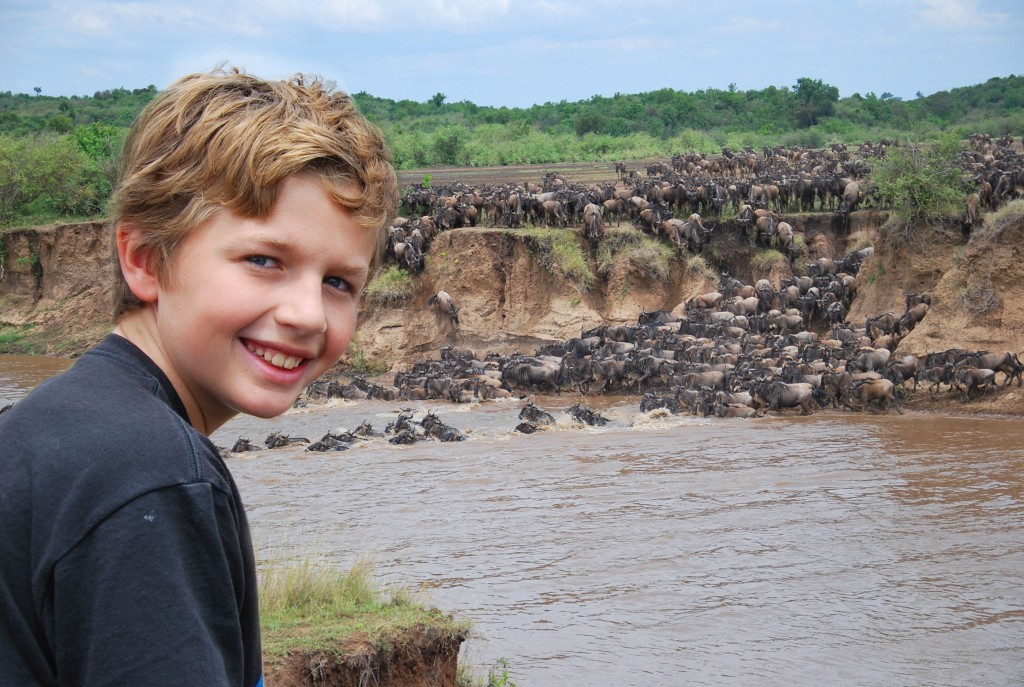The Great Wildebeest Migration and Other Stories from Kenya with Kids
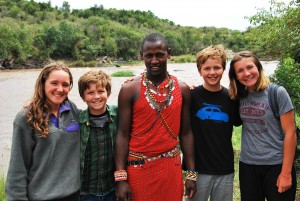 “I killed my first lion when I was 12 years old.” Moses said when we arrived at Alex Walker’s camp in Kenya. “He was leaping towards me through the dark night and when he was about 5-feet away, I leaned forward and speared him.” No longer a part of the passage to manhood rite, tales like this from the African bush are still passed from generation to generation. Moses is from the Masaai tribe and runs the camp. He explains that while he is still considered a hero in his village after killing not one, but two lions (for protection), that the event is no longer part of the Masaai initiation process like it was years ago when he was a boy. “We realize that lions are a precious addition to Africa and do not want to endanger them any more than they already are.” he explained. The journey to manhood incorporates many of the traditions of the past, but with a modern spin. “You don’t have to kill a lion to show you are brave.” says Mark, another Masaai warrior, and one of our guides. “Walking at night here is brave in itself.” Stories of their lives growing up in rural Africa, shared around the camp fire each night, intrigue our boys. And they have a blast going out with them, and our other guide Nyonogo, who teach Nathan and Seamus how to make and shoot bows and arrows, track animals and more. This is just one of the many reasons Alex Walker’s safari camps are great for families.
“I killed my first lion when I was 12 years old.” Moses said when we arrived at Alex Walker’s camp in Kenya. “He was leaping towards me through the dark night and when he was about 5-feet away, I leaned forward and speared him.” No longer a part of the passage to manhood rite, tales like this from the African bush are still passed from generation to generation. Moses is from the Masaai tribe and runs the camp. He explains that while he is still considered a hero in his village after killing not one, but two lions (for protection), that the event is no longer part of the Masaai initiation process like it was years ago when he was a boy. “We realize that lions are a precious addition to Africa and do not want to endanger them any more than they already are.” he explained. The journey to manhood incorporates many of the traditions of the past, but with a modern spin. “You don’t have to kill a lion to show you are brave.” says Mark, another Masaai warrior, and one of our guides. “Walking at night here is brave in itself.” Stories of their lives growing up in rural Africa, shared around the camp fire each night, intrigue our boys. And they have a blast going out with them, and our other guide Nyonogo, who teach Nathan and Seamus how to make and shoot bows and arrows, track animals and more. This is just one of the many reasons Alex Walker’s safari camps are great for families.
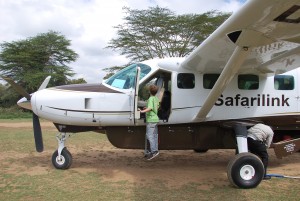 We began our journey flying from Nairobi to the African bush on Safarilink. The kids loved riding in the small plane – they even got to sit up front in the co-pilot’s seat at one point – and the views from the lower altitude were amazing! Just before we landed, on a dirt runway, we spotted hippos lazing by a river and lions perched on a hill. Nyongo and Mark met us and laughed, “Oh, there’s plenty more where that came from.” They drove us to our first camp, Alex Walker’s Nkorombo Mara Mobile.
We began our journey flying from Nairobi to the African bush on Safarilink. The kids loved riding in the small plane – they even got to sit up front in the co-pilot’s seat at one point – and the views from the lower altitude were amazing! Just before we landed, on a dirt runway, we spotted hippos lazing by a river and lions perched on a hill. Nyongo and Mark met us and laughed, “Oh, there’s plenty more where that came from.” They drove us to our first camp, Alex Walker’s Nkorombo Mara Mobile. 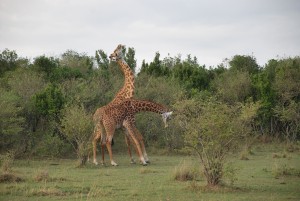 We were there during the infamous wildebeest migration and were anxious to see a “crossing” – where the wildebeest cross the river by the hundreds or thousands to seek out greener pastures on the other side (hey…the grass is always greener right?). But we got to experience so much more than that. On arrival, we saw zebras crossing the river next to hippos, gently picking their way away from the crocodiles on the banks. We witnessed giraffes fighting, lions eating, leopards with cubs, and much more! But the interaction with the Masaai people was one of the true highlights. Especially when we visited a traditional village and the kids learned to dance, and jump like Masaai warriors.
We were there during the infamous wildebeest migration and were anxious to see a “crossing” – where the wildebeest cross the river by the hundreds or thousands to seek out greener pastures on the other side (hey…the grass is always greener right?). But we got to experience so much more than that. On arrival, we saw zebras crossing the river next to hippos, gently picking their way away from the crocodiles on the banks. We witnessed giraffes fighting, lions eating, leopards with cubs, and much more! But the interaction with the Masaai people was one of the true highlights. Especially when we visited a traditional village and the kids learned to dance, and jump like Masaai warriors.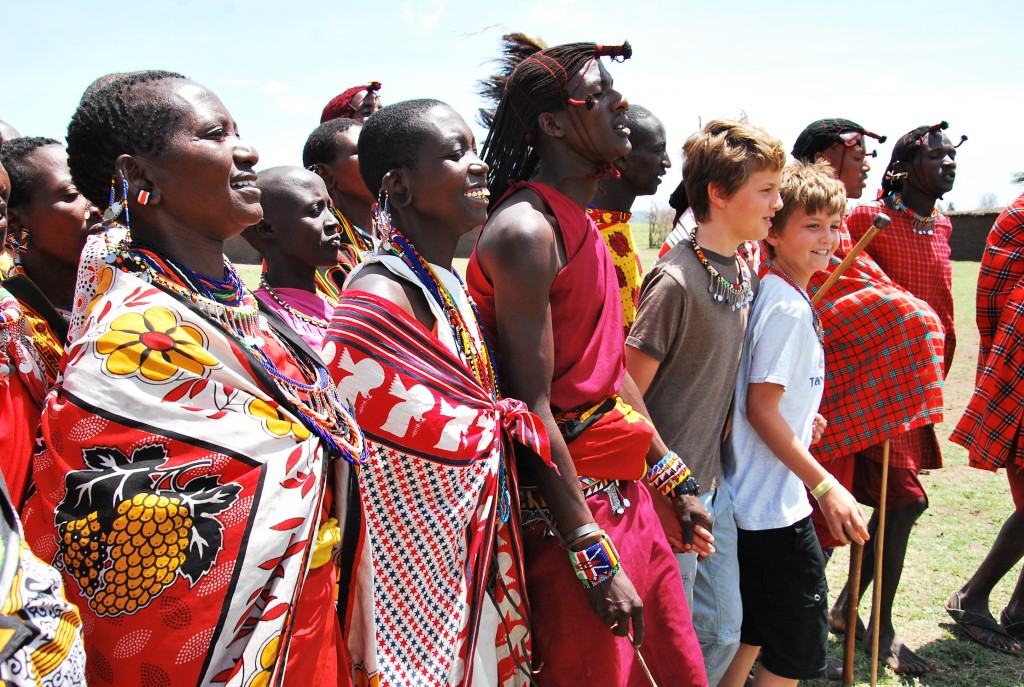
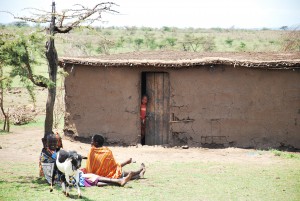 The village is set up around a circular interior courtyard where the cows sleep at night. The circle is surrounded by mud huts with a front room for smaller animals, a small bedroom area for the whole family. The brightly dressed villagers were all smiles and welcomed us into their homes. They sang in the most beautiful voices! Then, showed Nathan and Seamus how high they could jump (part of an initiation rite for warriors) and taught them a traditional dance. They told us how the younger generation did go to school, but after school on weekends, boys as young as five years-old were expected to herd goats (could be miles away from home – remember the animals we had just seen…yikes!) as part of helping their families survive. It was a very eye-opening and amazing experience!
The village is set up around a circular interior courtyard where the cows sleep at night. The circle is surrounded by mud huts with a front room for smaller animals, a small bedroom area for the whole family. The brightly dressed villagers were all smiles and welcomed us into their homes. They sang in the most beautiful voices! Then, showed Nathan and Seamus how high they could jump (part of an initiation rite for warriors) and taught them a traditional dance. They told us how the younger generation did go to school, but after school on weekends, boys as young as five years-old were expected to herd goats (could be miles away from home – remember the animals we had just seen…yikes!) as part of helping their families survive. It was a very eye-opening and amazing experience!
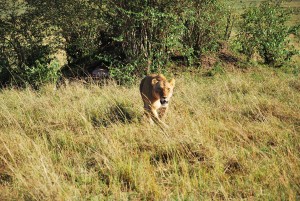 But back to the animals. One of the things the kids loved was the lions. One day, we sat and watched a lion stalk a wildebeest. He sat behind a small hill about 50-feet from the wildebeest who had no idea he was there. It was something straight out of National Geographic. The kids were amazed at how much the lion was like a house cat. He wiggled his behind as he got in position and darted peeks out from behind the hill. He inched forward on his belly. Seamus wanted to warn the wildebeest, but in the end it didn’t matter anyway. The lion shot out from the hill and the wildebeest jumped up and ran off, zigging and zagging, until the lone lion gave up the chase. Nyongo explained that lions usually hunt together because they have no stamina. So, if they are alone, they have to be very close to the prey to catch it. “The lions,” he said, “hang out by the river during the migration because often times the wildebeest are injured when they cross and then it’s free lunch for the lion.”
But back to the animals. One of the things the kids loved was the lions. One day, we sat and watched a lion stalk a wildebeest. He sat behind a small hill about 50-feet from the wildebeest who had no idea he was there. It was something straight out of National Geographic. The kids were amazed at how much the lion was like a house cat. He wiggled his behind as he got in position and darted peeks out from behind the hill. He inched forward on his belly. Seamus wanted to warn the wildebeest, but in the end it didn’t matter anyway. The lion shot out from the hill and the wildebeest jumped up and ran off, zigging and zagging, until the lone lion gave up the chase. Nyongo explained that lions usually hunt together because they have no stamina. So, if they are alone, they have to be very close to the prey to catch it. “The lions,” he said, “hang out by the river during the migration because often times the wildebeest are injured when they cross and then it’s free lunch for the lion.”
Speaking of the wildebeest migration…we did get to see a river crossing: about 3,000 wildebeest taking the river by storm. It was an epic moment and one that won’t soon be forgotten!
What struck us as funny about the whole crossing is the build-up. Thousands of wildebeest gathered along the banks of the river gazing across, looking around, grazing on grass. One would inch closer to the edge; others creeping up behind him. Then, he would turn away. Then, another brave soul would stray toward the water, then turn back. Then suddenly, some young chap at the back of the pack would make for the hills running full steam and the whole herd would follow in a quick retreat. 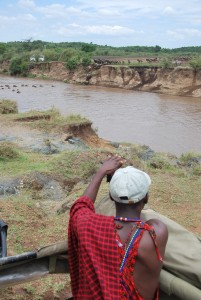 After the fear faded, they would gather once again at the river’s edge. This can go on for some time (it can be hours, or even days – lucky for us it was only about half-hour for the crossing we saw). The kids thought their jumpy nature was funny (and smart considering the lions lurking on our side of water). But, once the first wildebeest hit the water, it was like a swarm…they plowed through the river in a mass exodus, zebras following close behind. Once they started, it was just minutes for the 3,000+ to cross! And you know it’s good when the guides are taking pictures! (Right: Mark snapping shots in his phone)
After the fear faded, they would gather once again at the river’s edge. This can go on for some time (it can be hours, or even days – lucky for us it was only about half-hour for the crossing we saw). The kids thought their jumpy nature was funny (and smart considering the lions lurking on our side of water). But, once the first wildebeest hit the water, it was like a swarm…they plowed through the river in a mass exodus, zebras following close behind. Once they started, it was just minutes for the 3,000+ to cross! And you know it’s good when the guides are taking pictures! (Right: Mark snapping shots in his phone)
And speaking of our guides, Mark and Nyongo (at Alex Walker’s Serian) got us the best viewing spot for the wildebeest and all the animals we saw! They know their stuff! And they are great with kids!
Each evening, we all got to know the guides as we swapped stories around the camp fire and listened to the night sounds of the animals (especially the elephants at the salt lick and the hippos in the river just feet away!). And we got to know other families out on their own adventures. And after dinner, which was served at a long table set up in an open-air tent, we retired to our tents where we lounged in comfy beds and listened to the night sounds of the savannah. It was a beautiful family journey that we will talk about for years to come!
Overview:
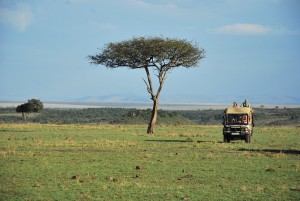 Masaai Mara National Reserve is located in southern Kenya, adjacent to Serengeti National Park in Tanzania (to the south). During the migration, best viewed between July and September, zebra and wildebeest (followed by predators) cross from the wide open plains to the smaller areas of the Mara in search of green grass. The sight of the wildebeest crossing is magnificent and because of the condensing of animals into a smaller space, the game viewing is outstanding.
Masaai Mara National Reserve is located in southern Kenya, adjacent to Serengeti National Park in Tanzania (to the south). During the migration, best viewed between July and September, zebra and wildebeest (followed by predators) cross from the wide open plains to the smaller areas of the Mara in search of green grass. The sight of the wildebeest crossing is magnificent and because of the condensing of animals into a smaller space, the game viewing is outstanding.
For information on our onward journey in Kenya, stay tuned for Part 2 of this article: Chasing Zebras, Napping Leopards, Treehouse Beds and more from a Family Vacation in Kenya
Getting There:
From Nairobi, Kenya, Safarilink operates flights to and between various game viewing areas and lodges. Flights range from about 30 minutes – one hour. The staff is very helpful and the low altitude allows you to view the rural scenery and villages below, and, as you get closer to landing, even some wildlife spotting.
Where to Stay:
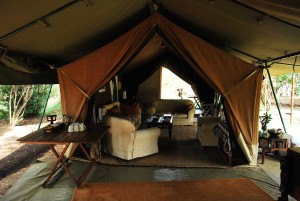 Alex Walker’s Nkorombo Mara Mobile is located along the Mara River in the southwestern part of the Masaai Mara National Reserve. Its location is ideal for viewing the wildebeest migration and many other animals and wildlife interaction. The tented camp offers guests a close encounter with nature (the sounds while laying in bed are amazing!) while at the same time enjoying modern comforts like attached toilet, hot water showers and fabulous food.
Alex Walker’s Nkorombo Mara Mobile is located along the Mara River in the southwestern part of the Masaai Mara National Reserve. Its location is ideal for viewing the wildebeest migration and many other animals and wildlife interaction. The tented camp offers guests a close encounter with nature (the sounds while laying in bed are amazing!) while at the same time enjoying modern comforts like attached toilet, hot water showers and fabulous food.
on Twitter
on Facebook
on Google+







